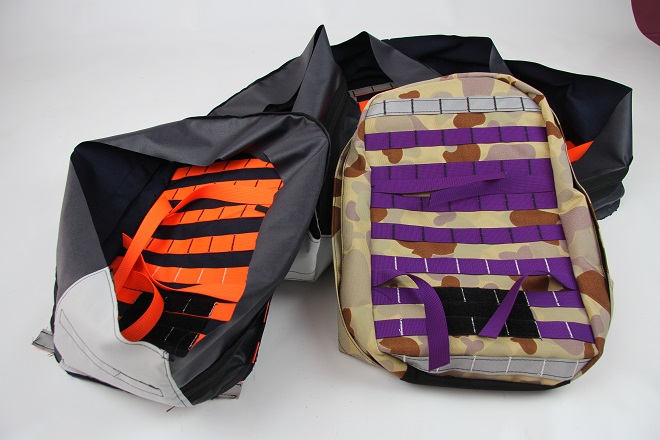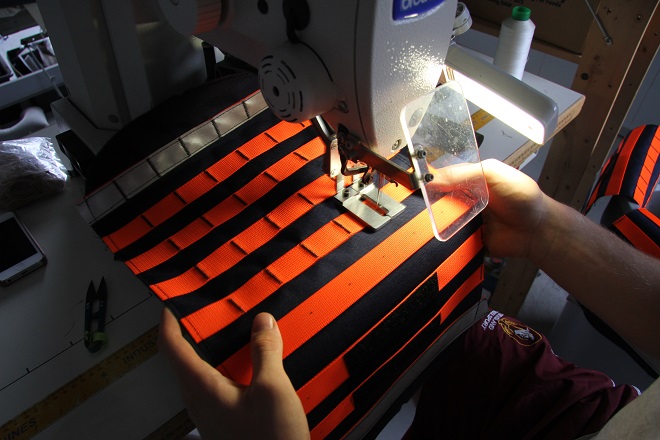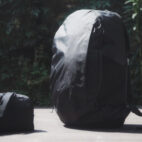Specialist Carry :: Forge Co. Frontline Pack
Firefighting is hard enough without having your equipment fail on you. One of the most important pieces of equipment is the bag that carries the rest of the gear – after all, if this fails you’re stuck awkwardly carrying gear in potentially life-threatening situations. So it may come as a surprise how much firefighters struggle to find suitable bags for their needs. Firefighter Michael McClean recognized this problem and decided to do something about it. The Forge Co. Frontline Pack almost never saw the light of day, but Michael shares his first-hand insight into the tough but rewarding journey…

Brand background
Over the years, we have developed world leading techniques and strategies and tools, equipping people working this dangerous task with specialised equipment. But we leave a huge part of their own safety to their personal wallet and a bunch of rag-tag “kinda-good-enough” products. The Frontline Pack is a new innovative safety item for Australian firefighters…and by that, we mean it’s tough as guts and will probably outlast you, and maybe even do your job better than you did anyway. Infinitely adaptable to the job at hand, this is a first for the toughest workers on the planet. It takes moments to adapt the pack from a simple, lightweight 3L water bladder carrier for times when mobility is of the essence and the truck is meters away to a full-sized day pack with easy-access cargo, admin and vital tear-off first aid kit.

Why does this pack need to exist?
The Frontline pack was developed through necessity. Firefighters in Australia, mainly bushfire, have always been picking something that does “alright” but isn’t specifically developed for them. This means a lot of lightweight hydration packs designed for cycling which rip, melt and fall apart. Or military-designed packs, which offer features we don’t use (I spent a year running one which allowed me to carry 8 M4 magazines…funnily enough I don’t need them on the fireground!). Others (older members mainly) use old ALICE webbing which can be cumbersome and some people go to a US style line-pack which works well enough again in some circumstances but not in others. We tend to do a lot more rolling-property protection and have more varied tasks as opposed to our US counterparts. Where they may have one job for an entire season (say, cutting hand tool lines), in one shift our crews will go from hand tools to working from the back of the truck, to lighting up on the side of a highway to kilometers deep in the bush with a huge hoselay and portable pump.
“Firefighters in Australia, mainly bushfire, have always been picking something that does “alright” but isn’t specifically developed for them.”
The Frontline pack was developed to give firefighters in Australia something that works for them and is designed for them. And happily, we’ve had heaps of interest from other services and areas of emergency services who have seen what we’ve done.

How did the product evolve?
The Frontline pack really started in my final year of high school. I was involved in some pretty big fires in my local area and had two packs destroyed during those campaigns and saw several others. I’d seen hydration packs get destroyed and damaged on the fireline before, but here we were working hard at what we train for in the worst conditions and safety gear was failing us! I had already been thinking about how to do it better, but that was when I realised it was a problem that really needed fixing.
I began with a heap of scribbling and drawing on my way to work. At the time I was working for a large outdoor and travel gear company so I was also looking at how they did things – construction methods, materials, harness design. I’ve always been very interested in carry and bags (ask my mum or girlfriend – I own a lot for a 19-year-old!) as well as design, so I had some ideas.
“I’d seen hydration packs get destroyed and damaged on the fireline before, but here we were working hard at what we train for in the worst conditions and safety gear was failing us!”
The possibilities of what it would end up like and how it worked were constantly changing. Modularity was always big, and it’s varied from a sling style through to a vest style of carry and everything in between. I’m very pleased with where it’s ended up though!

What kind of research did you have to undertake before kicking off the project? What did you need to wrap your head around?
What people actually wanted to carry! There was a survey I did and also talking to people about how and what they carried – lots of people had a hydration system and carried some gear…but nothing specific that was repeatable! Some carried half their house and others are still of the mindset that a 600ml bottle of water in a pocket is enough for them.
I also spent a lot of time researching fabrics – not just material but colour, and also other materials like buckles. There is some cool stuff out there!

What were the biggest challenges?
Finding a manufacturer. I’d talked to about 5-6 places and people before finding Dave at Brisbane Outdoor Gear, everything from factories in China to Australian manufacturers. No one really understood where I was coming from and that I was a one-man-band with a part-time job, a laptop and a pen. Not to mention no sewing experience and a bank account that was many zeros short of funding a startup.
When I got in contact with Dave he was just plain excited. Honestly the project was this close to grinding to a halt and falling over, but his enthusiasm and knowledge picked it back up and well, here we are!


One awesome thing that you learned while developing the product?
For every naysayer there is a stoked supporter! If you’re honest with your supporters and clients (and if you look at our Facebook and email list, you’ll see we’ve had our fair share of problems and 110% my mistakes!) then they’ll back you. There was a massive thing around pricing when we released it – what was cool was seeing names I had zero connections with from across the continent being supportive. It meant I knew we’d nailed it pretty well; you’ll always annoy some people but when people you don’t know are on your side it’s pretty cool. Build it and they will come.
“If you’re honest with your supporters and clients…then they’ll back you.”
Oh, and I’ve got to play with some cool gear and had a few tours of various facilities and organizational HQ’s and Operations centers…but I’m not allowed to talk about that! 😉

Who did you consult to make sure this pack will nail it for your intended user?
My brigade (Winmalee Rural Fire Brigade) was a huge support. The amount of times I’ve just brought a pack along and chucked it in front of a group to see what they think has got to be annoying by now. I also had several testers who were doing the same things in their own brigades and State Emergency Service Units. We had a big running log of feedback and Dave and I regularly sat down via phone or email and went through it all – what we could fix, what we couldn’t (yet!).
“We had a big running log of feedback and Dave and I regularly sat down via phone or email and went through it all…”
It’s also been to several state HQ’s for different services and the like. We’ve also sent out a heap of replies to interested parties both domestically and internationally that basically break the packs down to the very bottom and every thread is explained.

What did your brief look like? Is price part of that conversation?
At the beginning, the brief was basically a huge question mark! I had no idea if or how this thing would get made, but the further through we got the more I nailed down some key goals:
1) Flexibility – able to adapt to the task at hand.
2) Dependability – will last more than one season. The goal was always “You’ll retire before it will.”
3) Value – whatever the price, people should be able to see where, how and why their money goes where it does.
4) Professional – it can’t be just some fabric stitched together at home. It’s got to look the part and function well too.
The brief itself grew and shrank from pages on pages to just a short list. Each component had its own list of “Want/Will/Won’t” and its own brief too.
Price came in a few times – but we went for overkill. No skimping on fabric, build time or parts and features. If the prototypes went to market most people would be shocked at what they would cost – Dave and I knew they’d be expensive but even we were surprised!
“The brief itself grew and shrank from pages on pages to just a short list. Each component had its own list of “Want/Will/Won’t” and its own brief too.”
From there we went through with the testers and managed to incorporate their feature requests and lower the price tag to something that really is still very low for what the pack offers!

What are you most proud of with this design?
The modularity. That took time to get right and make sure it would actually work. We’ve dropped some compartments but they’ll be coming soon. It also gives us the chance to do custom pouches and compartments too, and be able to offer people the ability to just get what they need!


What flammability requirements are there with your gear?
That’s interesting and a question we get a lot. The most common method of pack destruction I see on the fireground is tears and snags followed by embers – really hot pieces of still burning material that settle and just melt their way through anything – your gear, pack, hose or even house!
We did some simulated ember work in Dave’s studio (yeah, burning things in a building full of fabric!) and came to the conclusion that the 1000D Cordura we used works above what’s required. At the time we weren’t sure what CorduraFR (Flame Retardent) we could get our hands on or from where. Since then, we’ve found a 500D CorduraFR that we want to experiment with on future products.
“The most common method of pack destruction I see on the fireground is tears and snags followed by embers – really hot pieces of still burning material that settle and just melt their way through anything…”
That said, it’s a pack with plastic buckles. Not cheap ones, but they will go before you do. But what I’ve been telling people (and my testers and I can back it up from experience!) is – if it’s hot enough your pack is on fire and your buckles are melting you’ve got way bigger problems. Our gear will be burning at that point and you’ll be having a bad day!

What are the most awkward tools firefighters carry?
Knapsacks. Knapsacks full stop. 25L of water in a big plastic jerry can on your back with a little hose. The number of knees and ankles those things would have to have claimed is ridiculous! We’re currently working on a way to have it be a bit more bearable.
As for stuff in the pack though? It depends. Often it’s lots of litte things that don’t play nicely, like knives and earmuffs, or lighters and fuel!

What are some things most people would not realize about the job?
It’s varied as anything. These packs get used for all sorts of jobs at all sorts of incidents. From carrying water while someone is lighting up to paperwork and a laptop in DivCom. We go to everything, bushfires are our “bread and butter” but structure fires, car accidents and also Search and Rescues, Retrievals and Body Recoveries are all part of the game. It’s a huge service with heaps of people which makes deployments fun too!

How important are your base layers for pack comfort? We can imagine they’d rub…
Yeah, heat and dirt and water is a horrible mixture, especially if you chafe easily! We use a 10mm EVA foam in the shoulder straps which is nice and soft, and also in the back panel and hipbelt. It’s a great compromise between load carry, suppleness and comfort. The production packs have a single removable 10mm piece but for a while the prototypes had 15mm of the stuff! Everyone who puts them on talks about the comfort and that’s something we’ve worked hard on.
“We use a 10mm EVA foam in the shoulder straps which is nice and soft, and also in the back panel and hipbelt. It’s a great compromise between load carry, suppleness and comfort.”
There will be times when these get worn for 12-16 hours straight. Even the shoulder straps are adjustable in three different places – if you’ve got wack shoulders at different heights you can adjust it to fit you.

What are the bits that still suck with firefighting carry gear?
Knapsacks again! And wet and dirty gear, because it stinks up everything and weighs a ton. There are proabbly more things that people will stick their hand up about because what people carry is very personal. I know that I’ve basically found a good spot for all my gear and the same with the testers, they’ve been finding some very creative packing solutions for stuff like chainsaw visors too! Plus with the secret pocket, I’ve finally stopped losing my keys and wallet on jobs.


How many packs were torched in the testing process?
Zero, just some fabric…oh and one of mine got a bit warm but no damage at all, except to my shin! The prototypes have been worked hard, from helicopters to boats on the open ocean and they’ve all perfomed without skipping a beat. That’s something I’m also incredibly proud and stoked about.

What is the most commonly used item that is tucked away in your pack? Is it easy to access this item on the fly?
Water, food or a nappy/facemask! The pack can fit two (not that we’d recommend 6L of waterweight!) 3L bladders in its hydration compartment and has all the tube management you could ask for. Food can be broken down into the tons of organization inside, and the dump pouch fits a nappy perfectly in between all the other gear it carries. Pens and pencils, maps and notebooks – things that lots of people struggle with packing in a way that won’t get them destroyed – also fit in the dump pouch neatly.

Can we see a layout pic of your firefighter EDC gear?
Yes! I also got my testers to do it too so you can see the variations in gear.









 Carry Awards
Carry Awards Insights
Insights Liking
Liking Projects
Projects Interviews
Interviews














